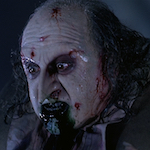 “It’s the so-called normal guys who always let you down. Sickos never scare me. At least they’re committed.” —Selina Kyle
“It’s the so-called normal guys who always let you down. Sickos never scare me. At least they’re committed.” —Selina Kyle
“He had graduated to a point where he wanted to make movies that are his movies. And this is one hundred percent Tim’s movie.” —BATMAN RETURNS producer Denise DeNovi
 On June 19, 1992 we got a blockbuster super hero movie unlike we’d seen before or have since. Since Tim Burton’s BATMAN RETURNS was about as much of a sure thing hit as a studio could ever have, and because the director had been unsure about doing another one, Warner Brothers left him alone to do what he wanted. So it’s a rare combination: an expensive summer blockbuster based on pop culture icons, but also an odd, personal film by an earnest visualist director without much interest in crowdpleasing spectacle. Okay, maybe that describes 1990’s DICK TRACY also, but this is DICK TRACY’s much freakier second cousin. As the first sequel to the movie that made comic book adaptations a hot commodity it was in a unique position to make up most of its own rules about what a super hero sequel is supposed to be, and it wasn’t timid about it.
On June 19, 1992 we got a blockbuster super hero movie unlike we’d seen before or have since. Since Tim Burton’s BATMAN RETURNS was about as much of a sure thing hit as a studio could ever have, and because the director had been unsure about doing another one, Warner Brothers left him alone to do what he wanted. So it’s a rare combination: an expensive summer blockbuster based on pop culture icons, but also an odd, personal film by an earnest visualist director without much interest in crowdpleasing spectacle. Okay, maybe that describes 1990’s DICK TRACY also, but this is DICK TRACY’s much freakier second cousin. As the first sequel to the movie that made comic book adaptations a hot commodity it was in a unique position to make up most of its own rules about what a super hero sequel is supposed to be, and it wasn’t timid about it.
I’ve written before about my love for the era of comic book movies that started with BATMAN and ended around BLADE or X-MEN. Since the medium that inspired them was still considered nerd shit, since digital FX were in their infancy, since most of them never worried about setting up a sequel let alone a cinematic universe, and since most were heavily influenced by what Tim Burton had done in BATMAN, the genre was very different from what it is today. There was far less literal fidelity to the source material (for good and bad), and relatively few attempts to depict extravagant super powers and creatures, meaning less falling back on visual effects sequences. Some tried to reimagine a pulpy past (THE ROCKETEER, THE SHADOW, THE PHANTOM, DICK TRACY), while the ones trying to be new and contemporary often celebrated colorful outsiders and weirdos (THE CROW, THE MASK, BARB WIRE, TANK GIRL, X-MEN). And I think my favorite thing about them is that they didn’t usually take place in “the real world.” They depended on a stylized look with big sets on sound stages, matte paintings and miniatures to create their own heightened reality.
 BATMAN RETURNS does all of these things, and in my opinion is the ultimate version of that type of movie. The fact that it was 1992’s highest grossing film at the North American box office but was more divisive than the first film may have been a boon for that wild period of movie making. It allowed the genre to continue without studio executives feeling like they had a handle on what the movies should be like or what would make them hits. That was still anybody’s guess.
BATMAN RETURNS does all of these things, and in my opinion is the ultimate version of that type of movie. The fact that it was 1992’s highest grossing film at the North American box office but was more divisive than the first film may have been a boon for that wild period of movie making. It allowed the genre to continue without studio executives feeling like they had a handle on what the movies should be like or what would make them hits. That was still anybody’s guess.
The one obvious choice Burton made: bring in a villain or two that everybody knows from the TV show. He went with The Penguin and Catwoman. Or at least he used their names and a partial idea of them, but he changed their looks and their origins and turned them into Tim Burton characters. His sketches that were the basis of their new designs fit right at home with his drawings for THE BLACK CAULDRON, EDWARD SCISSORHANDS, and THE NIGHTMARE BEFORE CHRISTMAS – creatures of Burton’s imagination as much as the pages of DC Comics.
A common criticism of both of Burton’s Batman films is that he seems more interested in the villains than in Batman, and that’s certainly true here if you’re measuring by screen time. While BATMAN begins with the title character saving a family reminiscent of his own from street criminals, the sequel opens in a mansion during the birth of Oswald Cobblepot, a.k.a. The Penguin. Born with flipper-like hands and a beak-like nose, kept in a cage, liable to attack pets, his rich-as-fuck parents (played silently by the PEE-WEE’S BIG ADVENTURE pair of Paul Reubens and Diane Salinger) conspire to dump him off a bridge one snowy Christmas night.
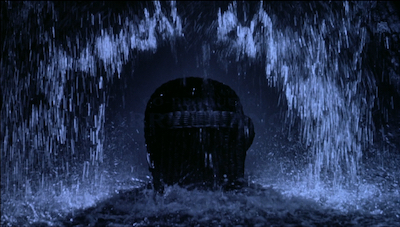 BATMAN’s credits play as we float through mysterious caverns that turn out to be the edges of a three-dimensional bat-symbol. RETURNS takes a similar journey following Baby Penguin’s wicker carriage as it floats through sewer pipes to the underground “Arctic World” exhibit of the (abandoned?) Gotham Zoo, where he’s greeted by curious emperor penguins. The title sequence (designed by Robert Dawson, REPO MAN, RE-ANIMATOR) sort of works as a flume ride, transporting us from our world to the new, more outlandish, more silent-film-inspired Gotham City. (On his commentary track, Burton confirms that he was thinking of Pirates of the Caribbean: “That little moment before you dip down into that first little waterfall. You always try to use elements that have sort of meaning for you.”)
BATMAN’s credits play as we float through mysterious caverns that turn out to be the edges of a three-dimensional bat-symbol. RETURNS takes a similar journey following Baby Penguin’s wicker carriage as it floats through sewer pipes to the underground “Arctic World” exhibit of the (abandoned?) Gotham Zoo, where he’s greeted by curious emperor penguins. The title sequence (designed by Robert Dawson, REPO MAN, RE-ANIMATOR) sort of works as a flume ride, transporting us from our world to the new, more outlandish, more silent-film-inspired Gotham City. (On his commentary track, Burton confirms that he was thinking of Pirates of the Caribbean: “That little moment before you dip down into that first little waterfall. You always try to use elements that have sort of meaning for you.”)
When we pick up again with The Penguin (Danny DeVito, ROMANCING THE STONE) at age 33 he, like The Joker before him (and the Green Goblin after him), enjoys interfering with city-organized celebrations downtown. He watches the tree lighting ceremony through a sewer grate literally under the feet of Christmas-shopping Alfred (Michael Gough, KONGA), then his Red Triangle Circus Gang goes on a tear that foreshadows the anarchic mischief of the alien invaders in Burton’s MARS ATTACKS!. Vincent Schiavelli (BETTER OFF DEAD) grinds an organ with a gatling gun inside, a strongman (Rick Zumwalt from OVER THE TOP, DISORDERLIES and PENITENTIARY III) hits Santa Claus with a sled, guys on stilts juggle torches (just for atmosphere, I assume), motorcyclists with amazing springy-eyed skull masks rip around the town square, a guy in a devil costume breathes fire onto a toy store display, a unicyclist fires a machine gun into the air… but Commissioner Gordon (Pat Hingle, THE LAND BEFORE TIME) turns on the bat signal and Batman shows up in the Batmobile to battle them all.
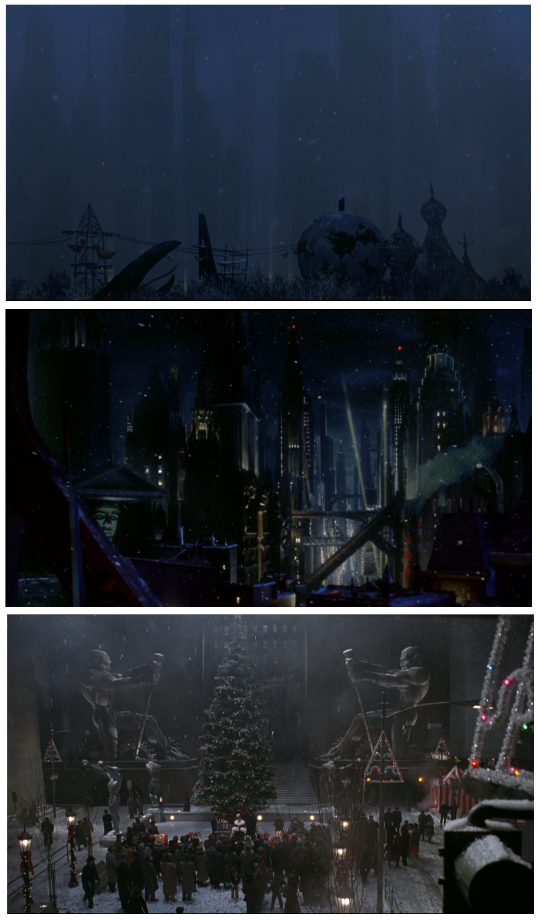
It’s not a bad entrance for the caped crusader, but it happens later than you’d think. Earlier, about 7 minutes in, the camera artificially panned up a skyscraper to where you’d figure he might be perched, but he was at home sitting in the dark looking sad. Instead it stopped on the penthouse office of department store mogul/industrial pollution king Max Shreck (Christopher Walken, A VIEW TO A KILL), who was trying to sell the Mayor (Michael Murphy, COUNT YORGA, VAMPIRE) on a power plant (that he doesn’t mention is designed to suck power, like a vampire) and got everyone to laugh at his “not properly housebroken” executive assistant Selina Kyle (Michelle Pfeiffer, THE WITCHES OF EASTWICK) for awkwardly trying to offer a suggestion while serving them coffee. The power dynamics in this employer-employee relationship will change drastically by the end of the movie.
But first Max is confronted by Gotham’s legendary “Penguin Man of the Sewer,” who brings him to his Arctic World hideout to blackmail him into basically helping with a PR campaign. “Somehow you’re a well respected monster and I am, to date, not!” So they stage a stunt where one of the clowns from the Penguin’s gang kidnaps the mayor’s baby during a speech and the Penguin “rescues” the baby. The acrobatic abductor stopping to lean into the mic and say “I’m not really one for speeches, so I’ll just say, ‘Thanks’” before hand-springing into the sewer is a one-line performance for the ages.
The performance fools the mayor, the media and briefly Bruce Wayne (who sympathizes with Oswald not knowing his parents) until he starts looking at old newspaper articles on micro-fiche in the Bat Cave and figures out the dude is a crimelord. Otherwise it goes over so well that Shreck, who has been threatening to make his employees sign a recall petition if the mayor doesn’t authorize the power plant, decides to run him for mayor.
RETURNS was the beginning of a period when many complained of too many villains in comic book movies, but all three of its heavies are among my favorites ever. Shreck gets many of the funniest lines and the most satirical parts of the story as the businessman who the organ grinder calls “The big guy, the guy who runs the show” even when he’s standing next to the mayor. In his office he has a taxidermied chihuaha named Geraldo and framed photos of himself with Ronald Reagan, Elvis Presley and Sammy Davis, Jr. He’s the kind of guy who under threat doesn’t just offer money and jewels, but to get them “with a minimum of fuss.” Who says that!?
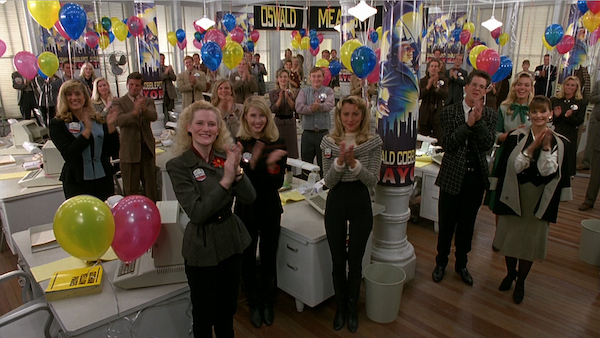 One of the funniest scenes is when Shreck convinces Penguin to run for mayor by luring him with a fish from his home to a fully staffed and furnished campaign headquarters that has somehow set been set up just down the open spiral staircase without his knowledge. The juxtaposition of this brightly-lit plasticity with the shadowy gothic world around it is a comedic trick Burton also used in EDWARD SCISSORHANDS. Of course it’s great to see SNL veteran and PEE-WEE’S BIG ADVENTURE Alamo tour guide Jan Hooks as an image consultant, but it’s Steve Witting (Burt from The Hogan Family) who makes the biggest impression by having his nose bit by Penguin.
One of the funniest scenes is when Shreck convinces Penguin to run for mayor by luring him with a fish from his home to a fully staffed and furnished campaign headquarters that has somehow set been set up just down the open spiral staircase without his knowledge. The juxtaposition of this brightly-lit plasticity with the shadowy gothic world around it is a comedic trick Burton also used in EDWARD SCISSORHANDS. Of course it’s great to see SNL veteran and PEE-WEE’S BIG ADVENTURE Alamo tour guide Jan Hooks as an image consultant, but it’s Steve Witting (Burt from The Hogan Family) who makes the biggest impression by having his nose bit by Penguin.
I’ve always enjoyed the joke of a literal monster with no qualifications or positive qualities being a serious candidate for office. It’s obviously true to life. Of course he runs on a “law and order/tough on crime” platform, with the slogans “Oswald Means Order” and “Cobblepot Can Clean It Up!” He has his own clowns (and a poodle) blow up stores downtown so he can say, “I may have saved the mayor’s baby, but I refuse to save a mayor who stood by helpless as a baby while Gotham was ravaged by a disease that turned Eagle Scouts into crazed clowns and happy homemakers into catwomen!” (Immediately after that statement a staffer tells him he’s “the coolest role model a young person could have,” and he gropes her.)
The part of the political satire that always rang false to me is the A FACE IN THE CROWD moment when Batman exposes The Penguin by hijacking the sound system during a rally and playing a recording of him bragging that he “played this stinking city like a harp from hell.” We now know, if we didn’t sense it then, that if a leader like this was exposed for saying repugnant things his supporters would not realize they’d been had, lower their signs and start booing him. This may sound like an exaggeration, but after the last six years I truly believe that if someone played a recording of Trump calling his supporters “squealing, wretched, pinhead puppets” during his speech and then he fired a machine gun into the crowd and leaped and tackled one of them and then ran off it would not end his political career, and most of the people in the crowd would still vote for him. No question in my mind at all. And there is zero chance the cops would shoot at him if they even tried to apprehend him.
 But it was the gender politics of RETURNS that got a big reaction at the time. In a positive way, I think. If you read my summer of ’91 retrospective we discussed what a cultural phenomenon THELMA & LOUISE was the summer before this. Here we have a more fantastical depiction of a single woman belittled and then assaulted by her powerful boss, finding a different side of herself and becoming an avenger. It was definitely seen by many as a feminist story, though she doesn’t seem to care about uplifting all women, judging by her disdain for a mugging victim she saves (Joan Giammarco, also in SINGLES that year, as was Burton) or the airheaded Ice Princess (Cristi Conaway, DOC HOLLYWOOD).
But it was the gender politics of RETURNS that got a big reaction at the time. In a positive way, I think. If you read my summer of ’91 retrospective we discussed what a cultural phenomenon THELMA & LOUISE was the summer before this. Here we have a more fantastical depiction of a single woman belittled and then assaulted by her powerful boss, finding a different side of herself and becoming an avenger. It was definitely seen by many as a feminist story, though she doesn’t seem to care about uplifting all women, judging by her disdain for a mugging victim she saves (Joan Giammarco, also in SINGLES that year, as was Burton) or the airheaded Ice Princess (Cristi Conaway, DOC HOLLYWOOD).
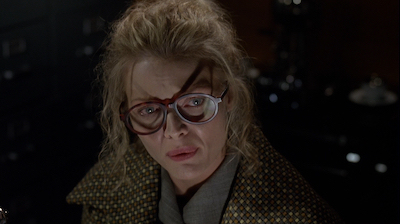
Pfeiffer (who took over for pregnant Annette Bening shortly before production) is phenomenal in the role. She somehow brings humanity and relatability to the most exaggerated possible version of the “mousy secretary” who takes her glasses off and finds a new confidence and sexuality. Screenwriter Daniel Waters (HEATHERS, THE ADVENTURES OF FORD FAIRLANE, HUDSON HAWK) masterfully constructs her transformation in a triptych of sequences:
1. She comes home to her small apartment after work, exhausted, pours milk for her cat, takes her shoes off, listens to her answering machine messages until she gets one from herself making sure she remembered to take home the Bruce Wayne file to study for tomorrow’s meeting. Whoops. So…
2. Back at the office Shreck finds her looking at files, and her blabbering reveals that she’s discovered his corrupt plans for the power plant. So he pushes her out a window into an alley, where cats swarm her and bite her fingers until she wakes up. And then…
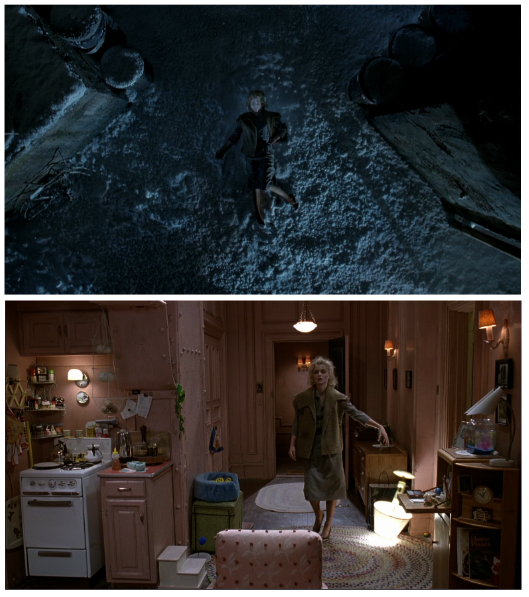 3. Returning home from work again she goes through a sort of zombie version of the same after work routine, saying the same things but knocking a lamp over, dropping her keys and coat on the floor, splashing the milk all around the cat bowl before chugging the rest from the carton, pouring it all over herself. Another robocall from Gotham Lady Perfume causes her to flip out and start wrecking things, putting stuffed animals in the garbage disposal, smashing the walls with a frying pan, spraypainting her wall and her kitty t-shirt, casually smashing her “HELLO THERE” neon sign into a “HELL HERE.” And then she haphazardly cuts and sews a black nylon rain coat into her Catwoman costume so she can do sexy poses on the window and tell Miss Kitty she feels “so much yummier.”
3. Returning home from work again she goes through a sort of zombie version of the same after work routine, saying the same things but knocking a lamp over, dropping her keys and coat on the floor, splashing the milk all around the cat bowl before chugging the rest from the carton, pouring it all over herself. Another robocall from Gotham Lady Perfume causes her to flip out and start wrecking things, putting stuffed animals in the garbage disposal, smashing the walls with a frying pan, spraypainting her wall and her kitty t-shirt, casually smashing her “HELLO THERE” neon sign into a “HELL HERE.” And then she haphazardly cuts and sews a black nylon rain coat into her Catwoman costume so she can do sexy poses on the window and tell Miss Kitty she feels “so much yummier.”
I’m not sure I ever gave much thought to the fact that her Catwoman persona uses an accent, I guess in homage to the 1966 show? I’ve always been so enamored of this version of the character that I never thought too much about all the silly things she does just to be cat themed: licking her paw clean, putting a bird in her mouth (apparently a real live bird, that’s why it looks so real when it flies out! What the hell?), saying “Meow” as a one-liner right before an explosion goes off, etc.
There’s also a sort of magical realism to the character you just have to go with. I’ve always took it that the fall doesn’t kill her, and the cats just wake her up (she’s twitching and her eyes are rolling, after all), and that when she later claims to have nine lives she’s just saying some badass shit about all the stuff she’s surviving, not actually dying multiple times. But I’ve learned over the years that some people do take it literally (which is how they treat it in CATWOMAN (2004), which started as a Waters-scripted spin-off for Pfeiffer but devolved into the standalone Halle Berry movie that’s mostly a rehash of this subplot). And there’s certainly an argument to be made for it – being constantly swarmed by cats isn’t normal unless you’re a Sleepwalker, and head injuries don’t normally turn clumsy people into high level acrobats, fighters and whip users. Before she had trouble pouring coffee and carrying papers, now she does flips, crawls up the sides of buildings and whips the heads off of mannequins. (Pfeiffer was trained by Anthony De Longis, who also trained Harrison Ford for RAIDERS OF THE LOST ARK, and she really beheaded those mannequins all in one shot!)
I find myself rooting for every facet of the character: the self-deprecating dork Selina at the beginning, the more confident Selina who romances Bruce, the joyfully wicked Catwoman who fights Batman, and the bitterly disillusioned Catwoman-unmasked-as-Selina who rejects Batman-unmasked-as-Bruce at the end. When she tells him, “I would love to live with you forever in your castle, just like in a fairy tale. I just couldn’t live with myself. So don’t pretend this is a happy ending,” it’s so dripping with resentment that a pretty on-the-nose line becomes an absolute scorcher.
Sometimes the different Selinas overlap, too, like when she laughs at herself after the humiliation of being punched off a building into a truckload of kitty litter.
The courtship and sexual tension between Bruce/Batman and Selina/Catwoman is so much more effective than most super hero romances that it doesn’t bother me having to accept their unlikely failure to recognize each other in/out of costume. At night they fight each other and in the day time they fit in early dates before they have to go fight each other. When they make out on a couch they have to hide their wounds from each other, when they learn of a kidnapping from the news they have to make up excuses to run off. They finally figure it out while dancing at the “Max-querade Ball,” where they’re the only people not wearing masks (because their faces are their masks). Selina, who as Catwoman has worked hard to screw over Batman, looks and sounds sincere when she says, “Oh my god – does this mean we have to start fighting?” At least in that moment she likes Bruce more than she hates Batman.
I’ve noticed an increasing number of people in the last few years saying that RETURNS is the best or their favorite of the live action Batman movies. I like that because in some ways it’s my favorite too, but with a caveat. I think I like it more as Burton’s interpretation of the world and people around Batman than as an actual Batman movie.
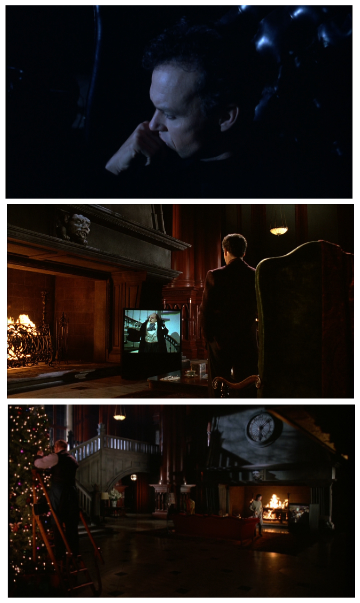
Don’t get me wrong, Keaton is great as Bruce Wayne – I love how much he lets us see him thinking – and it’s interesting that the characters around him also reflect on his character. Also, there are some cool parts where he uses ziplines and gliders and preposterous Batmobile devices and it’s a lot of fun. But for maybe the first half it seems like all he does is sit in the dark or watch TV until the bat signal comes on and then drive downtown, fight some clowns and come home. And when he’s framed for pushing the Ice Princess off a building (onto the button that lights the Christmas tree, which is full of bats, which terrorize the crowd – great planning by the Penguin and company) he just stands there like a dummy, doesn’t even reach for his bat-hook.
In a sense it’s more similar to the Adam West Batman and that era of comics than anyone (including me) seemed to recognize at the time. It’s just overflowing with absurd little gags, one of my favorites being when the Penguin’s plan goes south and some of the circus gang jump ship by cartwheeling out the door. (Gotham criminals are always committed to the bit.) Their boss’s evil plans are as goofy and simplistic as they come. First it’s to make Batman look bad by recklessly remote-controlling the Batmobile from the Penguin’s “Bat ‘o Ride” (a coin operated mini-Batmobile like they’d have outside of a K-Mart). But Batman finds the device they attached to the Batmobile and breaks it off. Then Penguin tries to kidnap the first-born sons of Gotham’s elite – his clowns put them on a circus train, but Batman immediately stops them. And my very favorite thing about the movie is that the Penguin riles up actual penguins with a Patton-style speech (“Many of you won’t be coming back”) and uses electrical devices to march them into town as suicide bombers. Alfred saves Gotham simply by jamming the signal and turning the birds around.
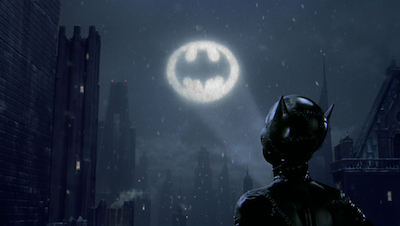 What’s miraculous about the movie is its ability to wink at us with all this stuff without at all undercutting the sincere melodrama. We feel the heartbreak and yearning at the end when Bruce spends another Christmas alone with Alfred – a scene that swaps the end of BATMAN so that he’s in the car like Vicki was, while Catwoman is on top of the building looking cool like he did. Even the death of the repulsive Penguin – muttering while black blood drips from his mouth, falling face first and being carried to the water by emperor penguin pallbearers – plays as tragedy. Elfman’s music does much of the heavy lifting there, with an assist from Keaton, observing solemnly from a distance.
What’s miraculous about the movie is its ability to wink at us with all this stuff without at all undercutting the sincere melodrama. We feel the heartbreak and yearning at the end when Bruce spends another Christmas alone with Alfred – a scene that swaps the end of BATMAN so that he’s in the car like Vicki was, while Catwoman is on top of the building looking cool like he did. Even the death of the repulsive Penguin – muttering while black blood drips from his mouth, falling face first and being carried to the water by emperor penguin pallbearers – plays as tragedy. Elfman’s music does much of the heavy lifting there, with an assist from Keaton, observing solemnly from a distance.
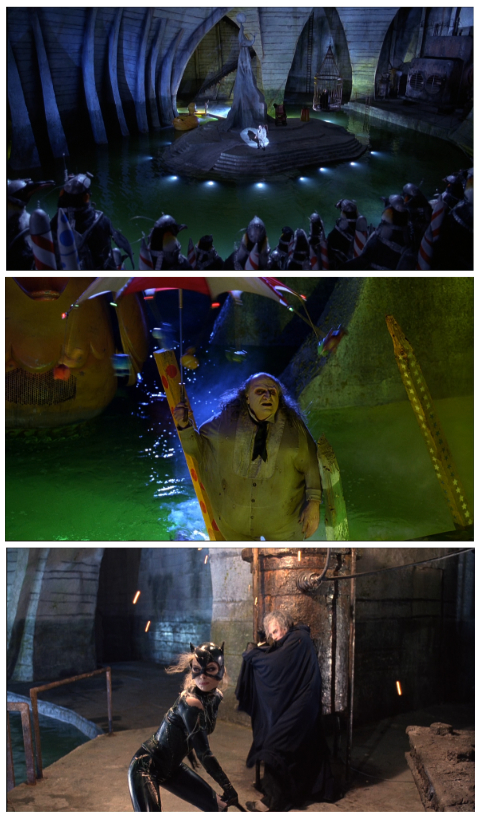
The main reason I decided that 1992 was “Weird Summer” is that two of its big blockbuster franchise sequels were strange works by visionary directors that were widely seen as dark and upsetting. We’ve already discussed how ALIEN 3 got that way despite director David Fincher’s dispiriting battles with the producers and studio, but BATMAN RETURNS is pretty much the opposite. This is one of the best examples ever of a blank check. Burton wasn’t initially interested in a sequel and the script by Sam Hamm (who retained a co-story credit because he used Penguin and Catwoman) didn’t appeal to him. But the studio offered him full creative control and found a good match for him with Daniel Waters. According to Tim Burton: An Unauthorized Biography of the Filmmaker by Ken Hanke, Waters “says that Burton virtually put it on a basis of ‘I dare you to make me make this movie’.” And obviously he won the dare.
According to a Fall 1995 issue of Imagi-Movies (a spin-off of Cinefantastique), Hamm’s version had Vicki Vale in it. Waters just had jokes about her, and had to fight for them, since Burton wanted the movies to be completely separate. In fact he says Burton wanted to just call the sequel BATMAN; he could’ve invented the sequel-with-same-title 26 years before HALLOWEEN (2018).
Waters’ script included a Robin subplot, which was removed by uncredited rewriter Wesley Strick (CAPE FEAR). Strick also noted the allusion to Moses with baby Oswald floating in the sewer and added the first born sons business. But his main job was to “normalize” Waters’ dialogue. “My script was written a little on the operatic side in terms of dialogue,” Waters told Imagi-Movies. “I tried to have psychology everywhere. I made a lot of the characters more reflective and cynical than Tim wanted… So with Wesley they wanted someone who could go in and turn a lot of my text into subtext, which is admittedly where it belongs. I don’t think anybody wants to hear Batman talking about how he’s ‘the light and the dark.’ Let Pauline Kael tell us that.”
The Hanke book quotes Waters as saying, “I was going to be the first writer to give Tim Burton a great story—three acts, bam, bam, bam. But after the first couple weeks with Tim, you realize it’s not going to happen. He just doesn’t think like that. He operates on this abstract, associative level… You learn to stop worrying and love Tim’s weird synapses, the way he puts things together.”
Despite what anyone might say about the lack of bam, bam, bam in the script, it 1) has way more still-laugh-out-loud-funny-after-30-years lines than most non-comedies and 2) is absolutely meticulous in its motifs of doppelgangers and mirror images, parallels and opposites. Bruce Wayne and Oswald Cobblepot of course reflect each other as only sons of the super rich, damaged by the loss of their parents (in different ways). They both have underground lairs with tunnel systems inhabited by the animals they’ve been named after. Bruce sympathizes with Oswald – I’m not sure Oswald knows Bruce exists. Max Shreck does know Bruce, but not well – when he sees Batman unmasked he asks, “Bruce Wayne – what are you doing dressed up as Batman?” Max reflects Bruce as an ultra rich businessman and Gotham celebrity. His NOSFERATU-inspired name and vampiric power plant concept are his version of bat theming. But his base of operations (his office) is above the city instead of below it.
The villains scheme to knock the Ice Princess off a building with a swarm of bats and make it look like Batman did it. Selina really did get pushed off a building by Max. Batman causes her to drop into a truck of kitty litter, Penguin causes her to drop into a greenhouse. Later, Batman intentionally uses a swarm of bats to knock the Penguin through a skylight and into his underground lair.
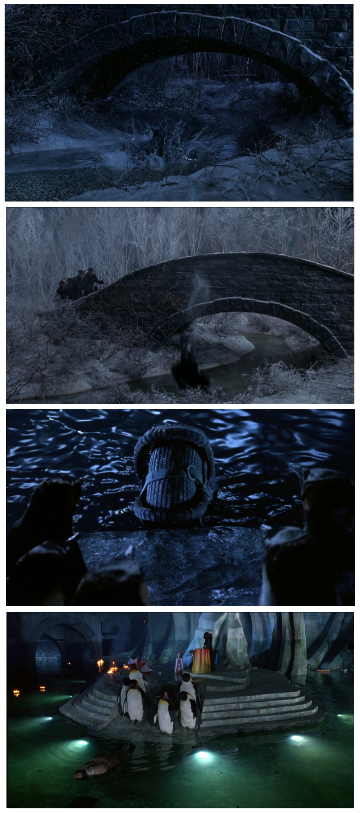 There’s also something almost palindromic about it. The first line of the movie is “Merry Christmas,” spoken by a couple passing the Cobblepots, not knowing they’re about to abandon their baby. The last line is Batman saying, “Merry Christmas, Alfred. And good will toward men. And women,” after being abandoned by Catwoman. Neither occasion is very merry.
There’s also something almost palindromic about it. The first line of the movie is “Merry Christmas,” spoken by a couple passing the Cobblepots, not knowing they’re about to abandon their baby. The last line is Batman saying, “Merry Christmas, Alfred. And good will toward men. And women,” after being abandoned by Catwoman. Neither occasion is very merry.
In that opening, Oswald’s parents throw him off the bridge and emperor penguins welcome him in Arctic World. As an adult he tells the people of Gotham, “A penguin is a bird who cannot fly. I am a man. I have a name. Oswald Cobblepot.” After exposed as corrupt, he runs and jumps off the same bridge his parents threw him from, returns to his lair and says, “My name is not Oswald! It’s Penguin! I am not a human being! I am an animal!” When he dies, the penguins put his body back in the water at the same spot where they found him.
And as for Max Shreck, in his first scene with Bruce he says, “One can never have too much power. If my life has a meaning, that’s the meaning.” In their last scene together Selina electrocutes him, because you can have too much power. So his life has no meaning.
As much as I love BATMAN, it doesn’t seem to have that level of thought put into it. I guess it would be hard to, with Hamm still writing the script while they were filming. Though Peter Guber and Jon Peters are still listed as executive producers for RETURNS, Burton didn’t have to battle with them this time, instead having the support of his EDWARD SCISSORHANDS producer Denise Di Novi, plus longtime John Carpenter collaborator Larry Franco.
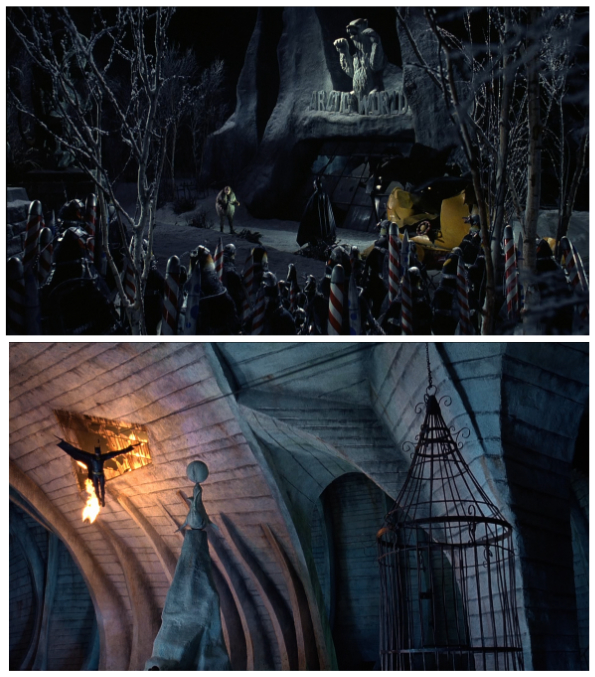
Much of the creative team had worked on SCISSORHANDS with Burton, but not the first BATMAN. That includes director of photography Stefan Czapsky (VAMPIRE’S KISS), editor Chris Lebenzon (TOP GUN), production designer Bo Welch (JOE VERSUS THE VOLCANO), art director Rick Heinrichs (previously his set designer), supervising art director Tom Duffield (THE LOST BOYS), makeup supervisor Ve Neill (Pee-wee’s Playhouse), and special makeup and effects producer Stan Winston (T2).
Of course, Elfman returning to score provided some continuity, with his themes and tones being so crucial to the Burton Batman feel. But he really elaborates on the sounds of Gotham with some of the new themes sounding more akin to his scores for SCISSORHANDS and even NIGHTBREED than the first BATMAN.
Burton also had full control of the songs, meaning he didn’t use very many. Prince’s Batman album had been an unlikely combination of corporate synergy and actual artistic brilliance, but it was forced on Burton, which is why most of the songs are pretty buried in the movie. For RETURNS, Burton specifically wanted a song by Siouxsee and the Banshees, which Elfman co-orchestrated to help fit with the score. Otherwise the only pop song is the Max-squerade band’s brief and intentionally cheesy rendition of Rick James’ “Super Freak,” orchestrated by Bruce Fowler, the trombonist for Frank Zappa and, around that time, Oingo Boingo. (I assume they chose it for the title, a joke about Batman.)
Together they created something wholly unique, otherworldly. I’m hard-pressed to think of a more gorgeous looking comic book movie, as much as you’d think their artistic origins would lead to highly visual adaptations. Even with the occasional reference to our world (The Love Connection, Nixon, Norman Bates – I really wish they didn’t mention Ted Bundy!) it’s easy to be transported to this timeless alternate present, where the mood is thick, the shit is crazy, and feelings run so deep sometimes you gotta put on a mask to become your true self.

Though RETURNS was a smash hit, there were many who felt it was “too weird” and “too dark.” It’s hard to imagine today, after we’ve experienced the Joker and Riddler of the quasi-realistic DARK KNIGHT and THE BATMAN, but there was controversy about it not being kid-friendly enough. Entertainment Weekly colorfully claimed that “in packed movie theaters across America, you can sometimes hear the sound of small children crying” because of “the scary scenes in PG-13-rated box office juggernaut BATMAN RETURNS… which kids, lured by a massive ad campaign by McDonald’s and diet Coke, are clamoring to see.” The article cites “the electrocution of a villain, circus clowns gunning down innocent victims, and the kidnapping and threatened murder of children” as examples of “the film’s darker side,” though of course most of those things also happened in the first BATMAN.
The article does provide evidence of at least a small “Batlash”: an NBC talk show host named Faith Daniels dedicating an episode to being upset about it, the L.A. Times publishing letters about it, and a Christian group called the Dove Foundation criticizing McDonald’s for having a Happy Meal “promoting a movie to little kids that’s filled with gratuitous graphic violence.”
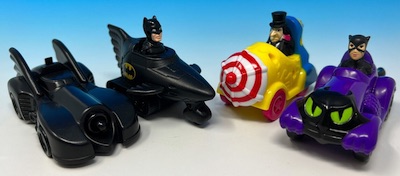 Many sources I found, including the “Kids Meal Wiki” and a Mashed.com article called “How McDonald’s Derailed Tim Burton’s Third Batman Film” claim the Happy Meals were “recalled due to dark content in the film,” but that’s not true. The promotion was already scheduled to end the week of the Entertainment Weekly article, and the toys (a Batmobile that shoots its front as a projectile, Batman’s head poking out of his sewer boat thing, Penguin in a funny little car with spinning spiral umbrella, and a smiling Catwoman in a silly Catmobile with wagging tail) can be found relatively cheap on eBay.
Many sources I found, including the “Kids Meal Wiki” and a Mashed.com article called “How McDonald’s Derailed Tim Burton’s Third Batman Film” claim the Happy Meals were “recalled due to dark content in the film,” but that’s not true. The promotion was already scheduled to end the week of the Entertainment Weekly article, and the toys (a Batmobile that shoots its front as a projectile, Batman’s head poking out of his sewer boat thing, Penguin in a funny little car with spinning spiral umbrella, and a smiling Catwoman in a silly Catmobile with wagging tail) can be found relatively cheap on eBay.
But it is true that Warner Brothers, stinging from the criticism, did not ask Burton to return for the third one, which upon release many considered an improvement over BATMAN RETURNS. (Words do not exist to express how strongly I disagree with them.)
But it was not entirely misunderstood or rejected. Many critics who didn’t like it could still recognize that it was up to something. Roger Ebert wrote, “I can admire the movie on many levels, but I cannot accept it as Batman.” While Rita Kempley of the Washington Post called it “bleakly visionary but dramatically obtuse,” the same paper’s Desson Howe wrote, “RETURNS is, in many ways, superior to its predecessor… Director Burton not only re-creates his one-of-a-kind atmosphere, he one-ups it, even two-ups it.”
David Sterritt of The Christian Science Monitor described it as “so unusual in its ideas and so extreme in its methods that word-of-mouth may not work in its favor. I find it the most adventurous and imaginative American film I’ve seen this year – and also the weirdest.” He also warned people to “be prepared for the movie’s startlingly dark overtones.”
David Ansen in Newsweek called it a “darker, weirder sequel” and “a visionary mess,” but also a “moody, grotesque, perversely funny $50 million art film” that he “wouldn’t trade 10 minutes of for LETHAL WEAPON 3, ALIEN 3 and FAR AND AWAY put together.”
Of the mainstream critics I think Richard Corliss in Time got it most right:
“BATMAN RETURNS could mark a happy beginning for Hollywood — not because it might make a mint but because it dispenses with realism and aspires to animation, to the freedom of idea and image found in the best feature-length cartoons. Most directors think pictures have to be anchored in the narrowest form of reality: the one that Hollywood has presented since the dawn of sound 65 years ago. Burton, once an animator at Disney, understands that to go deeper, you must fly higher, to liberation from plot into poetry.”
Was it really a “happy beginning” for “the freedom of idea and image”? Maybe it was – for that wave of ’90s comic book movies I described at the start of the review. But none of them really tried to match BATMAN RETURNS with its potent mix of expressionistic style, knowing but un-self-conscious absurdity and emotional sincerity. So maybe it’s time to try again.
POSTSCRIPTS:
awards: BATMAN RETURNS was nominated for Best Visual Effects and Best Makeup at the Academy Awards, and Best Kiss, Best Villain, and Most Desirable Female at the MTV Movie Awards. Also, of course, the clueless fuckin Razzies nominated DeVito for “Worst Supporting Actor.” If you’re wondering “what kind of tasteless assholes would actually think that?,” the answer is, of course, The Razzies.
merchandise: Of course BATMAN RETURNS inspired more tie-in crap than any other movie of the summer. Collector cards, collector cups, action figures (including “penguin commandos” and a repackaged Robin), die cast figures, PVC figures, rubber stamps, pencils, pencil sharpeners, coloring books, poster magazines, Super Nintendo, Sega Genesis and PC games…
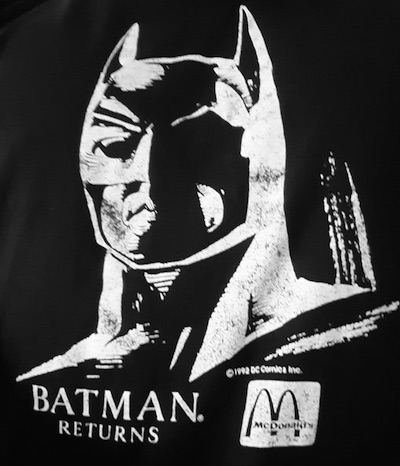 …far more stuff than I could ever catalog. I still have some of my BATMAN RETURNS crap I held onto from the ‘90s, the best of which is a t-shirt made for McDonald’s employees that I found at Value Village. Other than the McDonald’s logo it’s an elegant design and over the years it has developed the Platonic ideal of a weathered white-on-black silk screen that those phony “distressed” t-shirts aspire to.
…far more stuff than I could ever catalog. I still have some of my BATMAN RETURNS crap I held onto from the ‘90s, the best of which is a t-shirt made for McDonald’s employees that I found at Value Village. Other than the McDonald’s logo it’s an elegant design and over the years it has developed the Platonic ideal of a weathered white-on-black silk screen that those phony “distressed” t-shirts aspire to.
influence: I wish I could say I noticed the influence of BATMAN RETURNS in other movies, but I don’t. I do think that this interpretation of Catwoman became iconic and influenced the modern look of the comics character introduced by Darwyn Cooke in 2001.
Since Batman: The Animated Series was in production at the same time as RETURNS they gave their Penguin flipper hands, but went back to fingers when they redesigned the show. Some subsequent comics have given the character long hair and grotesque features, but maybe that version of the character is too specific to Burton’s sensibility to exist outside of his movie.

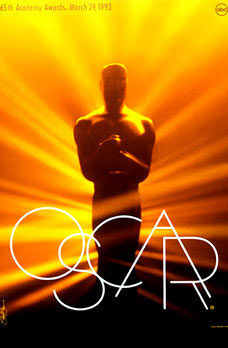

























July 11th, 2022 at 9:46 am
Fan of this movie too – I probably still prefer Burton’s first overall because my memory of that opening-night screen was it just being fun as hell with a highly engaged crowd. But something always drew me to the totally off-kilter feel of this one, there’s just something more dangerous and unhinged than the 1st movie lurking just under the surface. Some of its parts don’t really add up but it’s full of ambition and ambition goes a long way for me.
One of my favorite moments in the film barely involves superheroes or villains – it’s when Alfred brings Bruce something to eat while he’s working in the Batcave.
Bruce takes a spoonful of soup and spits it out. “It’s COLD!”
Alfred looks at him. “It’s vichyssoise, sir.”
Blank look.
Alfred: “It’s supposed to be cold.”
Bruce starts lapping it up.